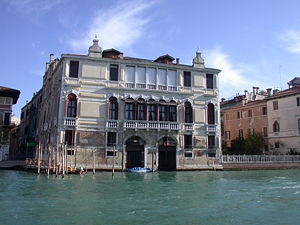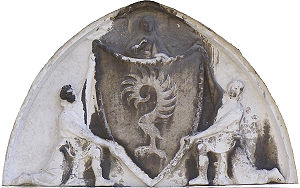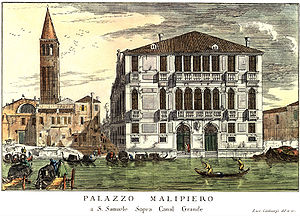
Palazzo Malipiero
Encyclopedia

Palace
A palace is a grand residence, especially a royal residence or the home of a head of state or some other high-ranking dignitary, such as a bishop or archbishop. The word itself is derived from the Latin name Palātium, for Palatine Hill, one of the seven hills in Rome. In many parts of Europe, the...
in Venice
Venice
Venice is a city in northern Italy which is renowned for the beauty of its setting, its architecture and its artworks. It is the capital of the Veneto region...
, Italy
Italy
Italy , officially the Italian Republic languages]] under the European Charter for Regional or Minority Languages. In each of these, Italy's official name is as follows:;;;;;;;;), is a unitary parliamentary republic in South-Central Europe. To the north it borders France, Switzerland, Austria and...
. It is located on the Grand Canal
Grand Canal of Venice
The Grand Canal is a canal in Venice, Italy. It forms one of the major water-traffic corridors in the city...
in the central San Samuele square.
It stands just across from Palazzo Grassi
Palazzo Grassi
Palazzo Grassi is an edifice in the Venetian Classical style located on the Grand Canal of Venice, northern Italy...
Exhibition Center.
It is situated at the crossroads of the city's cultural and artistic areas. The splendid Italian-style garden with a view on the Grand Canal
Grand Canal of Venice
The Grand Canal is a canal in Venice, Italy. It forms one of the major water-traffic corridors in the city...
makes it even more distinctive.
Originally built in Byzantine
Byzantine
Byzantine usually refers to the Roman Empire during the Middle Ages.Byzantine may also refer to:* A citizen of the Byzantine Empire, or native Greek during the Middle Ages...
times, the nine centuries' architectural history of the palace can be retraced in its complex structure: each generation of owners left its stamp of caring and fervour for the arts.
For some years as from 1740 Giacomo Casanova
Giacomo Casanova
Giacomo Girolamo Casanova de Seingalt was an Italian adventurer and author from the Republic of Venice. His autobiography, Histoire de ma vie , is regarded as one of the most authentic sources of the customs and norms of European social life during the 18th century...
lived in Palazzo Malipiero. In spite of his young age (he was just 15 years old), he began his successful social life in these very rooms. Here he gave a broad demonstration of his innate gift for the art of love.
The present owners have handled the recent restoration with special care in respecting the palace's historical background. They have maintained Palazzo Malipiero's ancient splendour and the traditional prestige, and, in upgrading installations and equipment to modern standards, improved the great comfort of its spacious rooms.
History
The Ca' Grande (big palace) of Saint Samuel was probably built at the beginning of the 11th century by Soranzo family, which also built in that period, together with the BoldùBoldu
Boldu is a commune in Buzău County, Romania. It is composed of a single village, Boldu....
family, the church of St. Samuel facing the Palace. In the 13th century a floor was added to the pre-existing bizantyne style' building, in accordance with to the custom at the time.
In the early days of the 15th century the Cappello family, one of the most energetic and industrious families of Venice
Venice
Venice is a city in northern Italy which is renowned for the beauty of its setting, its architecture and its artworks. It is the capital of the Veneto region...
, became owners of the Palace as a result of marriages with the Soranzos. As from the mid-16th century the Cappello enlarged the building and conferred to the facade on the Grand Canal
Grand Canal of Venice
The Grand Canal is a canal in Venice, Italy. It forms one of the major water-traffic corridors in the city...
its present shape.
Around 1590 the Malipiero
Malipiero
Malipiero is a Venetian surname of Bohemian origin, also documented as Mastropiero or Maripiero.Malipiero can refer to:-People:* Gian Francesco Malipiero Italian composer* Domenico Malipiero Venetian naval captain...
family became tenants of the Cappellos and Caterino Malipiero, within few years as from 1610, through the marriage with Elisabetta Cappello and further purchases, obtained ownership of the whole edifice. Evidence of the very many restorations done by him are the date 1622 and the initials K.M. -Caterino Malipiero- in an engraving placed over on the main door he built, giving access to the new large entrance of the Palace.
Around the year 1725, the Malipiero began new massive restoration works that gave the palace today's homogeneous aspect.
In the first half of the 19th century, with the Venetian Republic in full decline and after four centuries of successions, the Palace of the Soranzos, Cappellos and Malipieros suffered the same destiny as many other palaces of Venetian patrician
Patricianship
Patricianship, the quality of belonging to a patriciate, began in the ancient world, where cities such as Ancient Rome had a class of patrician families whose members were the only people allowed to exercise many political functions...
families: passing from hand to hand as a result of many transfers.
These transfers accelerated the decline of the building until the Barnabò family purchased it. In 1951 the Barnabòs undertook a substantial restoration, returning the palace premises to a grand and serene eighteenth-century style.

Giacomo Casanova and the Malipieros
Very little information could be collected as to the events that took place in the Palace. However, it appears that the Cappello family put the palace's storehouses to good use by developing the newly discovered printing and publishing activity there.What we know is that between 1656 and 1676, as a result of the construction of two very popular and successful theatres, a licentious way of life spread all over St. Samuel parish, and soon infected the palace.
We also know that Giacomo Casanova
Giacomo Casanova
Giacomo Girolamo Casanova de Seingalt was an Italian adventurer and author from the Republic of Venice. His autobiography, Histoire de ma vie , is regarded as one of the most authentic sources of the customs and norms of European social life during the 18th century...
, who was born on Calle della Commedia (later renamed Calle Malipiero), from 1740 frequented Palazzo Malipiero assiduously, as a confidant of Senator Alvise Gasparo Malipiero (Alvise II "Gasparo" Malipiero in Italian).
Here he established relationships with some influential persons and with a great many ladies. But one day the Senator caught him with Teresa Imer, on whom the Senator himself had invested some illusions, and Casanova was expelled from the Palace and later from Venice
Venice
Venice is a city in northern Italy which is renowned for the beauty of its setting, its architecture and its artworks. It is the capital of the Veneto region...
.
Casanova
Giacomo Casanova
Giacomo Girolamo Casanova de Seingalt was an Italian adventurer and author from the Republic of Venice. His autobiography, Histoire de ma vie , is regarded as one of the most authentic sources of the customs and norms of European social life during the 18th century...
left a lively portrait of Alvise Gasparo in his Memoires. The latter work is historically meaningful due to its portrait of the Venetian custom in the 18th century. In this bizarre and turbulent environment, the Malipiero suffered a passive decadent demise.
St. Samuel parish cultural life was revived only after 1950 when the Palazzo Grassi
Palazzo Grassi
Palazzo Grassi is an edifice in the Venetian Classical style located on the Grand Canal of Venice, northern Italy...
Cultural Center was established.
Palazzo Malipiero also contributes to Venice's Cultural heritage revival by hosting the exhibition spaces of Studio d'Arte Barnabò Gallery and Il Tridente multimedia publishing house.

Evolution
As with most Venetian palaces, the Cà Grande (Great House) of Saint Samuel is built as two main superposed floors, but unlike other palaces, each floor is accessed by its own independent entrance hall, stairway and porta d'acqua (water door).Through an ancient Byzantine door one accesses the “secondo piano nobile” (second main floor). The main door opens onto a large seventeenth century entrance hall leading to the magnificent “primo piano nobile” (first main floor) and to the ancient medieval court-yard, the19th century garden and the door on the Grand Canal
Grand Canal of Venice
The Grand Canal is a canal in Venice, Italy. It forms one of the major water-traffic corridors in the city...
.
The architectural development of the “Cà Grande di San Samuele” is similar to the traditional evolution of many Venetian palaces, the freedom and the harmony of structures underpinning the vivid rhythms and original fascination of the city.
In fact the structure of the building is made of three parts, each closely merged to the others, representing three eras: the Byzantine
Byzantine
Byzantine usually refers to the Roman Empire during the Middle Ages.Byzantine may also refer to:* A citizen of the Byzantine Empire, or native Greek during the Middle Ages...
style, the International Gothic
International Gothic
International Gothic is a phase of Gothic art which developed in Burgundy, Bohemia, France and northern Italy in the late 14th century and early 15th century...
style and the seventeenth century one.
The original part of the building was probably built between the 10th and 11th centuries by Soranzo family in Venetian-Byzantine style, as evidenced by the large door (number 3201) and the quadruple windows with round arches (later amalgamated into the gothic structure) visible on the San Samuele side.
In the middle of the 14th century, the Soranzo added a second floor to the Cà Grande, as evidenced by the pointed arch windows.
This Gothic design was perfectly amalgamated with the floor below, respecting and incorporating elements of the Byzantine construction.
By the mid-15th century the Cappello decided to expand the palace, too narrow at the time. Building on an unused area on the garden's side, the facade on the Grand Canal
Grand Canal of Venice
The Grand Canal is a canal in Venice, Italy. It forms one of the major water-traffic corridors in the city...
was widened to the dimensions we enjoy today.
Restoring and enlarging the building was also the main concern of Caterino Malipiero, as testified by the date 1622 and initials K.M. (Caterino Malipiero) engraved on the main door accessing the large Palace entrance.
The family’s coat-of-arms with cock's claws is also proudly sculpted there. In the second half of the seventeenth century, Palazzo Malipiero, its architecture ignoring Baroque
Baroque
The Baroque is a period and the style that used exaggerated motion and clear, easily interpreted detail to produce drama, tension, exuberance, and grandeur in sculpture, painting, literature, dance, and music...
, was one of the richest and most meaningful buildings in Venice
Venice
Venice is a city in northern Italy which is renowned for the beauty of its setting, its architecture and its artworks. It is the capital of the Veneto region...
.
In the first half of 18th century the Malipiero
Malipiero
Malipiero is a Venetian surname of Bohemian origin, also documented as Mastropiero or Maripiero.Malipiero can refer to:-People:* Gian Francesco Malipiero Italian composer* Domenico Malipiero Venetian naval captain...
family, in accordance with an architectural project now lost, decided to enlarge their Palace connecting it with some houses abutting it on its rear, eliminating the Calle Malipiero that separated them.
The facade on Campo San Samuele was extended backwards by 30 meters; the garden was widened to include part of a pre-existing Ramo Malipiero which bordered the Palace on the garden side, and a new perspective was created from the Palace’s main entrance to the garden.
This can be easily seen on the drawing of 1718 by Luca Carlevarjs and reproduced in the site home page. On it the palace ended after the two main entrances and a Calle borders its back end and separates it from the other houses that now are part of the building.
The drawing clearly depicts further back the Calle della Commedia where Giacomo Casanova
Giacomo Casanova
Giacomo Girolamo Casanova de Seingalt was an Italian adventurer and author from the Republic of Venice. His autobiography, Histoire de ma vie , is regarded as one of the most authentic sources of the customs and norms of European social life during the 18th century...
was born, and which was later renamed Calle Malipiero.
During the 19th century the venerable Cà Grande of the Soranzos, Cappellos and Malipieros was neglected but kept intact in its seventeenth-century structure; and it was only at the beginning of the 20th century that the palace saw some restoration.
Then, in the early 1950’s the Barnabò family started a complete renovation project. The works, directed by Nino Barbantini, restored the ancient charm to the palace, its interior and to the garden.
For the 2011 Biennale, the Palazzo Malipeiro served as the official Montenegro pavilion, which featured artist Marina Abramović.
Garden
The garden of Palazzo Malipiero was created, together with many others, at the end of the eighteenth century, when the large palace gardens situated on the outskirts of the city disappeared because of residential and industrial development.No doubt due to the particularities of the building plan, with a large entrance hall connecting Campo San Samuele to the courtyard, the garden's layout is most original: the area, compartmented by a simple design of hedge lines, extends along the building and is aligned both on the courtyard and the Grand Canal.
Thus the garden, when viewed from the Grand Canal
Grand Canal of Venice
The Grand Canal is a canal in Venice, Italy. It forms one of the major water-traffic corridors in the city...
, is divided in two symmetrical parts centred around a Hercule's Nymph fountain. The latter is also aligned with the 17th century entrance hall, so that a perspective view can be seen when entering the palace from the main door, through to the fountain a statue of Neptune
Neptune (mythology)
Neptune was the god of water and the sea in Roman mythology and religion. He is analogous with, but not identical to, the Greek god Poseidon. In the Greek-influenced tradition, Neptune was the brother of Jupiter and Pluto, each of them presiding over one of the three realms of the universe,...
inserted in the opposite garden wall.
In the garden has been placed the large well (originally in the inner courtyard) that, with the family coat-of-arms and the sculpted figures of the bride and bridegroom Elisabetta e Caterino, bear witness to the union between the Cappellos and the Malipieros.
From the end of 19th century, a number of statues have contributed to enrich the garden landscaping. The hedge, thanks to its intense colouring and precise pruning, conveys a further sophisticated touch to this precious garden.

